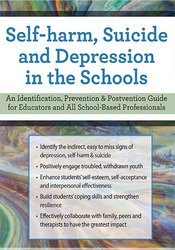

The school years are fraught with turmoil and strife for kids. In addition to the usual unrest, many of your students will be affected by emotional and/or mental health issues. They may present with dropping grades, decreased class participation and negative acting-out behavior. For some students, these issues escalate into more severe and complex behaviors that cause harm to both themselves and others.
These students often become emotionally withdrawn, exhibit extreme mood swings, become severely depressed and may even resort to self-harm and/or suicide. These issues pose a serious challenge to you and your school.
As an educator, you are in the unique position to identify, help and support these struggling students. This recording will examine the best strategies for identification, prevention and postvention among students with depression, self-harm and suicidal ideation. Emphasis will be placed on understanding how to detect and respond to at-risk students at the individual level, classroom level and school-wide level.
You will learn strategies, techniques and interventions to provide the appropriate support and effectively help students cope. Whether you are a classroom teacher, school counselor/psychologist/social worker, administrator or support staff, you will leave this seminar armed with tools you need to connect with and help students who most need your help.
| File type | File name | Number of pages | |
|---|---|---|---|
| Manual - Self-Harm, Suicide and Depression in the Schools (1.61 MB) | 48 Pages | Available after Purchase | |
| Manual for Parts I-II - Self-Harm, Suicide and Depression in the Schools - French (1.61 MB) | 48 Pages | Available after Purchase | |
| Manual for Parts I-II - Self-Harm, Suicide and Depression in the Schools - Italian (1.61 MB) | 48 Pages | Available after Purchase |
John Bearoff, PhD, has over 40 years of experience in a wide variety of settings including as a classroom teacher, substitute teacher, school psychologist, and private practitioner. This diverse background allows John to speak from a unique perspective of understanding - on all levels. John is a Certified School Psychologist and Clinical Psychologist.
Dr. Bearoff has conducted more than 300 in-service programs to school districts around the country. Topics for educators include grief/loss intervention, stress management with students and staff, crisis intervention, depression and suicide intervention and creating safe schools. John has been responsible for initiating and developing district wide programs on grief/loss intervention/postvention, student assistance programs for drug and alcohol intervention. He also created suicide prevention and anti-bullying programs for several large school districts.
In addition, John has been the chairperson for school district committees created to establish district-wide Safe Schools plans. He has also been the chairperson for multicultural awareness committees, which established school district policies relating to diversity and tolerance.
Speaker Disclosures:
Financial: John Bearoff is in private practice. He receives a speaking honorarium from PESI, Inc. He has no relevant financial relationships with ineligible organizations.
Non-financial: John Bearoff has no relevant non-financial relationship to disclose.
Please wait ...